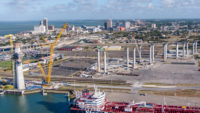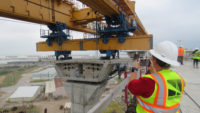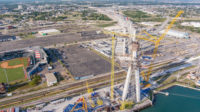Texas officials are threatening to replace the contractor building a $930-million bridge crossing the Corpus Christi Ship Channel, alleging the firm has failed to address previously identified safety concerns with the design. In response, the contractor says the state has delayed sharing key engineering information and insists the design is safe.
The Texas Dept. of Transportation issued a notice of developer default on Aug. 16 to Flatiron/Dragados LLC, the joint venture behind the design-build project to construct a replacement Harbor Bridge in Corpus Christi. The move is the latest escalation in a dispute over the design, as TxDOT officials say there are deficiencies that the project team has so far failed to address. In July, TxDOT ordered the contractor to halt work on the main span of the cable-stayed bridge.
Marc Williams, executive director of TxDOT, said during a press conference that the move is intended to address the serious concerns about the project and the contractor’s “lack of responsiveness” regarding those concerns. The contractor has repeatedly assured officials that the issues would be addressed but has not made any changes or notified the state of any schedule for correcting nonconforming work, he said.
Flatiron/Dragados has 15 days to respond to the notice and address the alleged design flaws.
“Should the contractor fail to adequately address the concerns in this time frame, TxDOT will issue a formal default and begin the process to replace them as the contractor on the project,” Williams said.
A spokesperson for Flatiron/Dragados did not immediately respond to inquiries. In a letter responding to TxDOT’s order to suspend some of the work on the bridge last month—which TxDOT posted online with other documents related to the dispute—Flatiron/Dragados project manager Keith Armstrong wrote that the design is safe and that its own designers and third parties have not found the defect issues to be correct.
TxDOT hired International Bridge Technologies (IBT), a subsidiary of French transportation engineering firm SYSTRA, to review and validate the design. According to Armstrong’s letter, IBT submitted an initial report to the state last year, but TxDOT did not initially share the findings with the project team, and only finally shared a version of the report this spring, eight months after construction recommenced and just days before a dispute hearing.
“TxDOT’s decision not to disclose IBT’s work on the project; its decision not to disclose IBT’s initial report; and its decision to wait three months to provide necessary data relating to IBT’s April 2022 report are not consistent with current claims of urgency,” Armstrong wrote.
State officials issued a notice of nonconforming work to Flatiron/Dragados on April 29, then ordered a temporary halt on work on the main cable-stay bridge July 15. Armstrong’s letter states that Flatiron/Dragados requested a meeting in June to discuss some of the design elements in questions, but received a response that TxDOT “is not directing FDLLC’s means or sequencing of the progression of the work.”
Armstrong alleged that state officials refused to hold any meetings without the contractor first acknowledging the nonconforming design, despite its genuine belief that the design is not defective.
“This position is not conducive to a resolution,” he wrote.
However, Williams told reporters that there had been “numerous meetings” between TxDOT, IBT and the contracting team.
“Flatiron/Dragados has refused to acknowledge the safety issues that have been identified or to take any steps to correct them,” Williams said.
Nonconforming Design Elements
As ENR previously reported, TxDOT officials highlighted five design elements as “nonconforming” based on IBT’s report. They include tower drilled shafts, which IBT says would be subject to exceptional concurrent overloading at multiple shafts within the same foundation cap. Those foundation caps also do not meet requirements for resisting flexure and shear when faced with wind events, according to the report.
IBT also identified what it says are several deficiencies with the delta frame-to-box girder connection design. Some of the intermediate piers would not be able to transmit lateral loads once uplift occurs, according to the report. Finally, the bottom slab of the back span superstructure would have insufficient post-tensioning during construction.
The design calls for a 1,661-ft-long, six-lane-wide main span carrying Interstate 37, U.S. 181 and State Highway 286. The project also includes connecting roads and reconstruction of an interchange, as well as demolition of the existing Harbor Bridge.
TxDOT had previously raised concerns about the design, and had the original engineer-of-record, FIGG Bridge Engineers, removed from the project. Arup and CFC were added as the new engineer-of-record in 2020.
Armstrong wrote in his letter that Flatiron/Dragados has tried to minimize impacts on the project schedule despite the dispute and order to halt work on the main span. Crews have been reassigned to other parts of the project in the meantime.
Williams said he could not speculate on how much the project’s timeline would be impacted by the current situation. TxDOT will pursue contract remedies to recover any added costs, he said.
“This is a generational bridge, and we want to see it done right,” he said.






Post a comment to this article
Report Abusive Comment